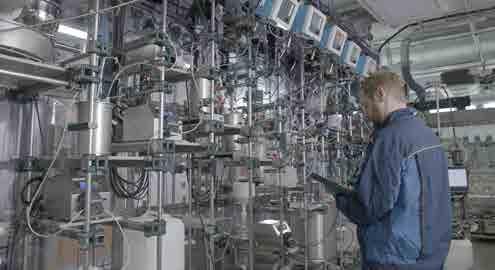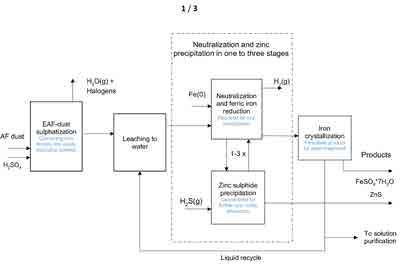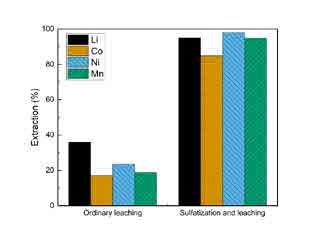
12 minute read
Pertti Koukkari, Teppo Riihimäki, Pirkka Ollonqvist
from Materia 4/2022
The Comeback of the Sulphate Route in Recycling Metals
The sulphate method in titanium dioxide pigment manufacturing
The Vuorikemia plant, founded in 1961 in Pori, produced approximately 130,000 tonnes of TiO2 pigment, 500,000 tonnes of ferrous sulphate heptahydrate and approximately 100,000 tonnes of ferrous sulphate monohydrate per year. The raw material used to be ilmenite (35-40 % TiO2 and ca 50 % iron oxides) as recovered from the Otanmäki mine (closed in 1985), then shipped from, e.g., Norway. In recent years a concentrate slag with reduced Fe content was also used. The process applied significant amounts of sulphuric acid by which the ilmenite ore was digested, hence the name sulphate route.
The Pori plant had been evolved to be a competitive unit with its own sulphuric acid production with a capacity of 175,000 t to 240,000 t per year. The lead time from the raw material to the final TiO2-product was about two weeks (10-14 days) with long delays at different process steps including reactions, clarifications and several product recovery units. The multi-stage operation undeniably was one of the most sophisticated hydrometallurgical processes that produced a bulk commodity in industrial scale [1].
A serious fire at the Pori pigment plant in the autumn of 2017 destroyed about a third of the plant’s equipment and after a short period of reconstruction planning the present owners decided not to rebuild the historic Vuorikemia plant.
New opportunity: recovery of metals from waste oxides
However, the interest in hydrometallurgical processing has gained new power due to its obvious benefits as a low-carbon operation in recycling voluminous metal-containing side streams and waste, typically consisting of oxides or hydroxides or even sulphates. Yet, many of these materials are either complex with several metal cations to be recovered or they may include coupled oxidation states and structures, which causes challenges in recovery yields when conventional leaching methods are used. The technologies applied in the traditional sulphate route manufacturing of TiO2 may offer interesting possibilities for such processing.
The sulphate route applies hot and fairly concentrated sulphuric acid for the digestion of ilmenite, thus producing a solid mass of (mainly) titanylsulphate (TiOSO4) and ferrous-ferric sulphate [i.e., FeSO4 and Fe2(SO4)3]. The ‘cake’ can then be dissolved in mild acid, forming the aqueous sulphate solution. The salient feature of the further operations is then to convey the processing >
VTT's hydrometallurgical FlexMet-pilot in KIvenlahti.

Figure 1. The block diagram of VTT’s CircMet process concept
under reducing conditions, so as to maintain iron in the ferrous form to prevent its premature precipitation. This is achieved typically by running the pregnant solution through baskets of scrap iron, to control both pH and redox in the system.
The respective methods have been recently applied to two recycling challenges, to recover both iron and zinc from the electric arc furnace (EAF) dust of steel industries and to reclaim the Li-ion battery (LIB) metal values from the recycled electrode material (‘black mass’).
EAF dust to zinc concentrate and ferrous sulphate
Inside the EU 74 MT of electric arc furnace crude steel was produced in 2018. Assuming a generation of 17 kg dust/tonne of EAF steel, 1,26 MT of zinc-enriched EAF dust is then generated. With the European recycling capacity of 1,1 MT, most of the zinc in EAF dust is currently recycled inside the EU, while worldwide 50- 60 % of EAF dust is yet landfilled.
The prevailing high temperature technologies used in EAF dust treatment, such as the Waelz kiln process, generally focus primarily on the recovery of zinc, leaving iron and heavy metals like lead in the discard slag. In a typical Waelz kiln, this residue amounts up to 3 tonnes per tonne of Zn recovered and forms a potentially harmful waste that cannot be reused but gets landfilled. Other pyrometallurgical treatments exist, yet they inherently produce a substantial amount of CO2 emissions as fossil carbon is typically used as the reductant.
To valorise the full metal content and to reduce the carbon footprint a new hydrometallurgical approach has been developed at VTT [2]. The treatment applies the proven chemistries of the sulphate route coupled with known sulphide precipitation methods into a holistic recovery process. Preliminary tests completed during the last 24 months have confirmed over 95% zinc recovery from sulphatization-leaching in the process. Subsequent treatment with conventional hydrometallurgy recovers zinc as ZnS (sulphide) concentrate to offer a feedstock for zinc manufacturing. Iron is recovered from the residual solution either as ferrous sulphate commodity, used as a water treatment chemical, or as an additive in animal feed, agriculture, pigments, cement, optionally also as recyclable ferric oxide raw material for steelmaking.
In figure 1 the flowsheet of VTT’s CircMet process for recovering both zinc and iron from EAF dust is shown. The dust typically contains 15-35 % Zn, while its Fe content is 20-45 %. Depending on the dust history, various percentages of other metals, such as alkalis, Pb and Mn are also present. In the hot acid treatment, the temperature rises to ca 200 oC, which also allows for evaporating the possible halogen residues of the dust. The metals will form the respective sulphates, which are soluble in the subsequent water leaching. The leaching residue contains silica as well as Ca and Pb-sulphates. In the subsequent operations, Fe is reduced to ferrous iron by using scrap, while the reduction reactions also tend to rise the solution pH to 2-3, allowing undisturbed ZnS precipitation. The reduction stage will evolve hydrogen from the acidic solution which in the conventional TiO2 process was ventilated. However, in CircMet the evolved H2 could be recovered and used for the necessary H2S generation. In figure 2, the EAF dust used as a raw material in VTT’s laboratory scale tests is shown together with the ZnS and FeSO4*7H2O (ferrous sulphate heptahydrate) products. The (partial) elemental analysis of the dust and both products is given in Table 1.
Leaching ‘Black Mass’ metals into the sulphate solution
The use of lithium-ion batteries (LIBs) is growing rapidly, primarily for electric vehicles (EVs)—worldwide sales of which are projected to grow to over 11 million annually by 2030 —but also for stationary storage by utilities and residences, and the demand for consumer electronics remains also strong. Worldwide demand for, e.g., cobalt for battery production could con-

Figure 2. EAF dust (left) with the two main products Zn-sulphide and Fe-sulphate_heptahydrate
Figure 3. Comparison of yields: direct acid leaching (left), leaching of sulphated Figure 3. Comparison of yields: direct acid leaching (left), leaching of sulphated mass (right)mass (right) Table 1. Typical analysis of the EAF dust and products from VTT’s laboratory In figure 3, a comparison of the ordinary direct acid leaching of black mass with diluted sulphuric acid tests (w-%) [2,3] without any additives and the sulphatization method is shown. It was found that the sulphatization Material Ca Fe Mn Pb Zn Senhanced the extraction of key elements significantly compared to ‘bare’ direct acid leaching. Sulphatization caused clear increase in the extraction, achieving the best extraction of 85%, 98%, 95% (Co, EAF-D 1.7 % 24.0 % 3.0 % 1.3 % 39.0 % 1.1 % Ni and Mn). Li extraction was generally higher than any of the Ni, Co and Mn which was an expected result. ZnS 0.1% 2.7 % 0.2 % - % 58.0 % 31.0 % The extractions indicate that the ‘sulphate route’ method would allow for agreeable yields to a pregnant solution without using costly chemicals (such as hydrogen peroxide) to enhance the leaching result [6,7]. FeSO4 0.52% 23.0 % 1.26 % 0.0009 0.4 % 17.2 %Further recovery of the metal values could be performed with conventional hydrometallurgical fractionation methods (e.g. sulphide precipitation for Ni and Co, Mn as MnO2), yet the details of, e.g., the efficiency of the halogen (fluoride) removal and eventual Li yield will need further research. sume about 14% of current cobalt reserves by 2050. Other salient metals in the LIB are nickel and manganese.
Black mass is used as the colloquial term Conditions of feasibility for fine fractions containing the active electrode materials of spent batteries. In the case In both cases, the experimental results lead to high metals recovery to the sulphate solution. Acid to solids of lithium-ion batteries, the black mass conratio will affect the yields. In general the stoichiometric ratio of 1:1 should be nearly sufficient, yet increasing it as in the latter (LIB) case may beneficial. Even higher yields are obtainable by using additional reductive leaching and recycling the leach residue. MATERIA 4/2022 55 The sulphate route operational costs remain moderate in terms of its chemicals and utilities consumption [3 Ollonqvist et al.]. For the recycling of battery metals the income from the products (battery metal salts)
sists of conductive carbon, graphite, binder polymers and various lithiated metal oxides whose efficient recycling is deemed as a necessity. However, the present methods of LIB-recycling (reaching yields of some 80+ % of Ni and Mn, somewhat lower of Co and Li) are regarded as unsatisfactory, e.g., by the EU. The Commission has recently published a proposal for updated EU Battery Directive including a mandated recovery of Ni: 90%, Co: 90%, Li: 35% by 2026 and Ni: 95%, Co: 95%, Li: 70% by 2030, although the legislation is not yet adopted [4,5].
A hydrometallurgical challenge in recycling lithiated transition metal oxides has been that it is difficult to dissolve the oxides within conditions akin to traditional hydrometallurgical processing of primary minerals – i.e., atmospheric leaching with sulphuric acid. The lithiated mixed oxides are in higher valence state and the challenge of dissolving these oxides can be considered reminiscent of the challenge of, e.g., MnO2 or Co3O4. Dissolving the valuable metal oxides (e.g., LiCoO2 or LiNi1/3Co1/3Mn1/3O2) directly from black mass with sulphuric acid is thus challenging, as the oxide structure has rendered challenging to dissolve with high extraction efficiency.
Following the sulphate route, the black mass containing the LIB metals (Ni, Co, Mn, Li and Al) as oxides is dried, and then mixed well with concentrated and heated sulphuric acid. Here, too, the temperature is raised due to exothermic sulphatization leading to a fast reaction and release of the halogens as evaporated hydroacids. It may also be assumed that in this process some elements present in the black mass, such as metallic Fe, Cu or Al can help in breaking the high-valence oxide structure by acting as a reductant. As in the EAF case, the acidic sulphatized mass is then leached in water at a moderate temperature.
In figure 3, a comparison of the ordinary direct acid leaching of black mass with diluted sulphuric acid without any additives and the sulphatization method is shown. It was found that the sulphatization enhanced the extraction of key elements significantly compared to ‘bare’ direct acid leaching. Sulphatization caused clear increase in the ex- >

traction, achieving the best extraction of 85%, 98%, 95% (Co, Ni and Mn). Li extraction was generally higher than any of the Ni, Co and Mn, which was an expected result. The extractions indicate that the ‘sulphate route’ method would allow for agreeable yields to a pregnant solution without using costly chemicals (such as hydrogen peroxide) to enhance the leaching result [6,7]. Further recovery of the metal values could be performed with conventional hydrometallurgical fractionation methods (e.g. sulphide precipitation for Ni and Co, Mn as MnO2), yet the details of, e.g., the efficiency of the halogen (fluoride) removal and eventual Li yield will need further research.
Conditions of feasibility
In both cases, the experimental results lead to high metals recovery to the sulphate solution. Acid to solids ratio will affect the yields. In general the stoichiometric ratio of 1:1 should be nearly sufficient, yet increasing it as in the latter (LIB) case may beneficial. Even higher yields are obtainable by using additional reductive leaching and recycling the leach residue.
The sulphate route operational costs remain moderate in terms of its chemicals and utilities consumption [3]. For the recycling of battery metals the income from the products (battery metal salts) should well cover the recycling costs. As for EAF dust recycling, the economy of the process will require raw dust with high enough zinc content, the limit of which can vary depending on circumstances. Yet, as the profitability limit of the Waelz kiln requires at least 15 % zinc content in the dust, it is anticipated that for the sulphate route the threshold may be even lower, due to the additional FeSO4-product. The further process development will include the development of purification for the recycled sulphate solution to remove, e.g., manganese and the inherent neutralization chemicals. It is, however, foreseen that also here marketable side products can be recognized.
From the environmental and climate point of view, the sulphate route, somewhat akin to that applied at the Pori site, seems to offer a benign solution. While also the process chemistry and economy appear promising, the actual feasibility of the sulphate route will require additional studies regarding the practical engineering operations. These include the sulphatization (reactor may be different from the kind used in the TiO2 process due to the higher bulk density of the dust compared with the ilmenite concentrate), filtration of the leach residue and recovery and re-use of hydrogen evolved in the reduction stage. Further pilot operations are being planned by VTT and its co-operation partners to solve such problems. The development work will then eventually show whether there will be a new life for the sulphate route, serving the needs of the future circular economy.
[1] Evilampi, T. (1990): FINNTITAN pigmentit ja niiden valmistus Porissa, Painorauma Oy, 54 s. [2] Riihimäki, T., Ollonqvist, P., Koukkari, P., Rastas J., (2021): Hydrometallurgical process for waste materials of the zinc and steel industries, Finnish patent application No. 20216173 [3] Ollonqvist, P., Riihimäki, T., Koukkari, P. (2022): New Hydrometallurgical Treatment to Recover Zinc and Iron from EAF Dust, Erzmetall 75 No. 1, 28-35 [4] https://eur-lex.europa.eu/legal-content/EN/TX-
T/?uri=CELEX%3A52020PC0798 )( 6.5.2022) [5] https://www.europarl.europa.eu/RegData/etudes/ATAG/2022/729285/EPRS_
ATA(2022)729285_EN.pdf (6.5.2022) [6] Porvali, A., Rintala, L., Koukkari, P. (2022):
A method for recycling metal values from the spent Li-ion batteries, Questel Research
Disclosure, Database number 696070. [7] Porvali, A. (2020). Complexities of Hydrometallurgical Recycling of Spent NiMH and Li-ion
Batteries. (Dissertation, Aalto University.)
VTT on kehittänyt terästehtailla syntyvien sinkkiä ja rautaa sisältävien jätepölyjen kierrätykseen uuden hydrometallurgisen menetelmän. jossa kahden jätevirran keskinäistä kemiaa hyödynnetään uusien tuotteiden valmistamiseksi molemmista. Pölyn vaikeasti liukeneva sinkki ja rauta saadaan aluksi vahvahappokäsittelyn avulla helposti veteen liukeneviksi. Syntyneestä liuoksesta saostetaan sulfidirikaste sinkinvalmistuksen raaka-aineeksi. Pölyn sisältämä rauta otetaan talteen sinkin saostuksen jälkeen rautasulfaattina.
Lisäksi prosessin erikoisuus on romuraudan käyttö happaman liuoksen neutralointi- ja pelkistyskemikaalina. Liuennut rauta saadaan edelleen talteen sulfaattituotteena, jolloin vältetään kipsi-, jarosiitti- ja rautahydroksidisakkojen tai sulfaattipitoisten jätevesien muodostuminen ja prosessi muodostuu lähes jätteettömäksi. Rautasulfaatilla on hyvät markkinat mm. jäteveden puhdistuksessa ja sementin lisäaineena. Ympäristöhyötyjen lisäksi raudan käyttö parantaa näin myös prosessin kannattavuutta.
Prosessikehityksen taustalla on Suomessa pitkään toimineen Porin Vuorikemian tehtaan käyttämä, vahvahappokäsittelyyn perustunut sulfaattimenetelmä, jossa titaani- ja rautaoksideista koostuneesta ilmeniittimineraalista valmistettiin maali- ja muoviteollisuuden tarvitsemaa titaanipigmenttiä ja mm. vedenpuhdistuksessa käytettyjä rautasulfaatteja.
Uudelle kierrätysprosessille on haettu patenttia. Sen hyödyntäminen EU:n alueella syntyvän yli miljoonan pölytonnin kierrättämisessä kiinnostaa alan yrityksiä sekä Suomessa että Keski-Euroopassa. VTT on saanut lupaavia tuloksia sulfaattireitin käytöstä myös akkumetallien kierrätyksessä.
Uusiutumattomia luonnonvaroja ja kriittisiä mineraaleja säästävien kierrätysprosessien kehittäminen on tulevaisuuden kestävän kiertotalouden kynnyshaaste. Sulfaattireitin käyttö on esimerkki mahdollisuudesta käyttää eri jätevirtojen keskinäistä termodynamiikkaa hyväksi suljettujen materiaalikiertojen toteuttamisessa.
TEKSTI:PERTTI KOUKKARI, TEPPO RIIHIMÄKI, PIRKKA










